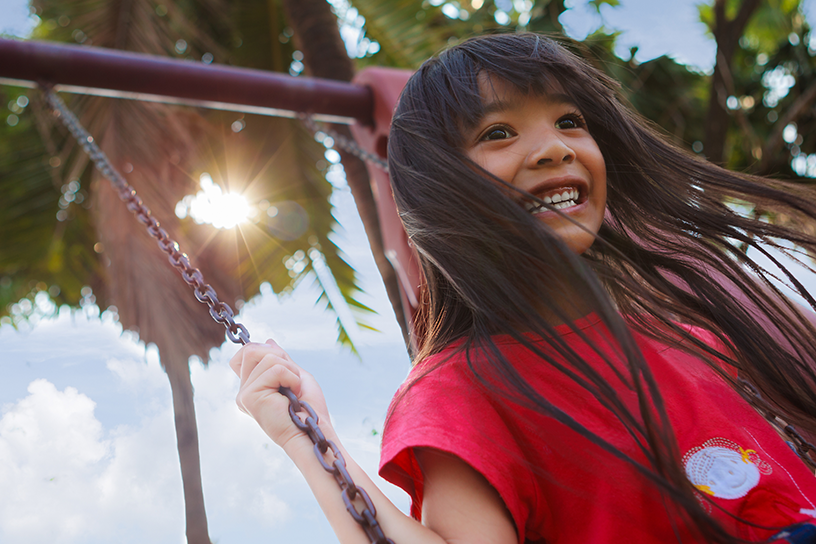When installing a playground, choosing an appropriate surface is one of the most important decisions you’ll need to make. In addition to prioritizing safety, you’ll want to select a surface that is affordable, durable, and low-maintenance. Let’s take a look at the pros and cons of the two main playground surfacing options: loose-fill and unitary.
Loose-Fill Playground Surfacing Options
Loose-fill playground surfaces are a go-to option for many public playgrounds. There are several options on the market to choose from that will fit your budget and style.
Loose-fill surfacing options include:
- Engineered wood fiber (EWF)
- Rubber mulch
- Loose-fill rubber
Installation
Loose-fill playground surfaces are easy to install. We recommend installing a containment border and geotextile filter fabric to structure your space and prevent weeds and grass from growing through your loose-fill material. Then, simply rake your loose-fill material to create a smooth surface. We also recommend using wear mats under swings, slide runouts, and high-traffic areas for extra protection. With one final check to ensure adequate depth, you can welcome children to your playground in no time.
Cost
Loose-fill playground surfacing options are typically more affordable upfront. Most will run you between $1 and $3 per square foot. However, loose-fill options may be more costly in the long run. They can compress up to 25% over time and will need to be replenished to maintain appropriate depths. High-traffic areas like slide exits and swings may also require raking or smoothing as part of your daily or weekly playground maintenance. And, you’ll need a containment border for your playground to prevent your loose-fill surfacing from being kicked or blown into the grass or into surrounding areas.
Safety
Loose-fill playground surfacing is generally considered very safe. However, there are a few considerations to keep in mind. Although it is ADA accessible, it is difficult for children or adults who use wheelchairs or use other mobility devices to easily maneuver the playground. It can also be a choking hazard for toddlers and young children. As with the nature of loose-fill materials means that hazards like broken glass or trash can easily get mixed in, so keeping your playground clean is key.
If you opt for a loose-fill surface, regular playground inspections are essential to maintaining a safe experience for children at play.
Unitary Playground Surfacing Options
Unitary playground surfacing is comprised of either a poured surface or flat strips/tiles that are laid on a grid. It comes in a variety of fun and kid-friendly colors and is considered one of the most durable and affordable choices on the market.
Unitary surfacing options include:
- Poured-in-place rubber
- Bond-in-place rubber
- Interlocking rubber tiles
- Synthetic grass/turf
Installation
The installation process varies for unitary surfaces, depending on if you opt for a poured/bonded product, tiles or turf. It is important to remember that these unitary surfacing choices require a concrete base or one of crushed compacted stone that has been tested for compaction specifications.
Cost
Because they are so durable and long-lasting, unitary playground surfaces tend to be more expensive upfront. Most surfaces will cost you between $8 and $20 per square foot. They may also come with higher installation fees since the process is more technical than with loose-fill options. Plus, you don’t want to forget the cost of the recommended subbase of unitary safety surfacing.
However, unitary surfaces require minimal playground maintenance over the years. A small allowance for playground repair to fix any holes or tears is all you’ll need to account for the long-term cost of your surface.
Safety
There are relatively few safety hazards to worry about with unitary surfacing. The main issue is that some options (like poured, bonded, and tiled rubber) can become slippery when wet. Interlocking rubber tiles can also become a tripping hazard if a tile comes loose, so you’ll need to secure your tiles properly and perform regular playground inspections to ensure they remain in place. It is also important to have these unitary surfaces tested to insure the appropriate impact attenuation.
Which Playground Surfacing Is Best?
The best playground surface for your playground will depend on a number of factors, including:
- Your budget and the size of your playground
- The age of the children playing on your playground
- The types of playground equipment present
- The resources you have available for regular playground maintenance
You can also mix surfaces for different areas of your playground. It is becoming more and more common to use unitary surfacing in high-use areas like slide exits and swings, and loose-fill surfacing under platforms and to fill open spaces. Mixing and matching allows you to enjoy the affordability of loose-fill surfaces with the safety and durability of unitary surfaces.
Worried your current playground surfacing isn’t up to code? Have your surface tested to ensure it’s safe for children of all ages.





